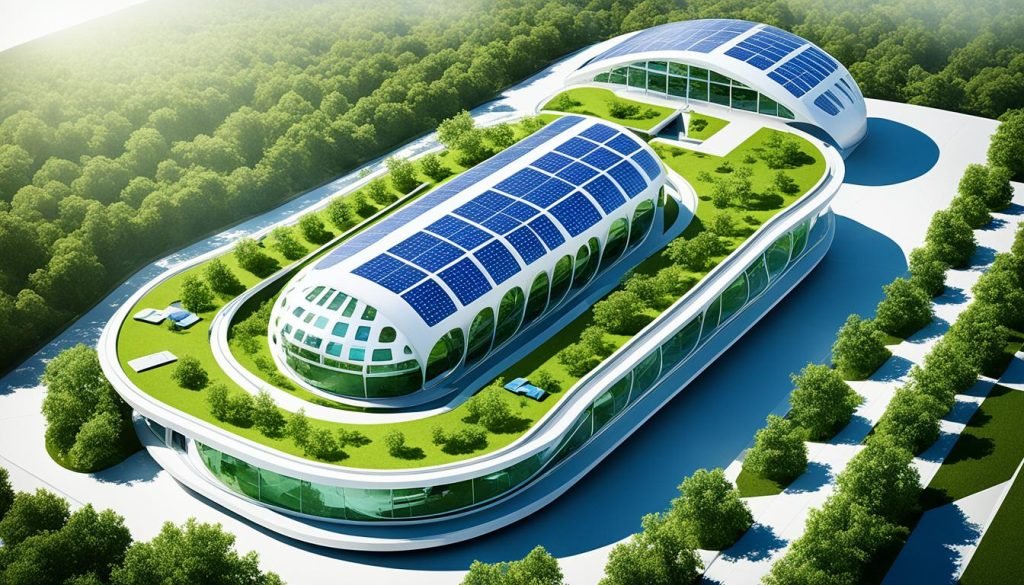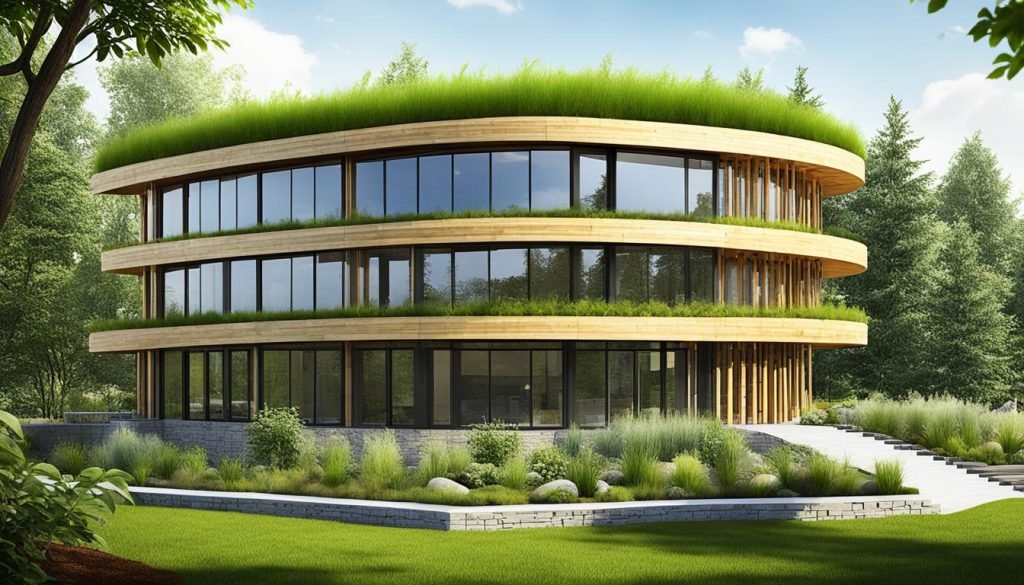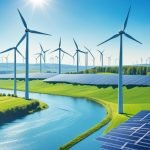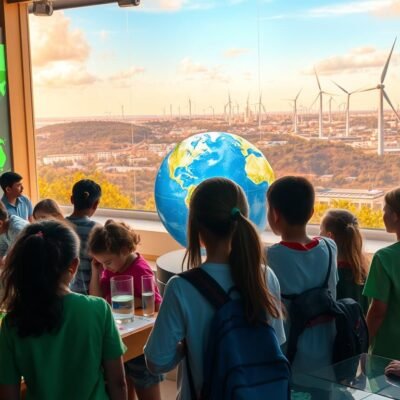In recent years, the construction world has changed a lot. Now, there’s a big push for green building technologies. This shift shows how important it is to think about the planet and use eco-friendly ways to build. These new methods help cut down on harm to the environment and save money over time.
By focusing on sustainable development, builders are using less waste and energy. This helps make our planet healthier. We’ll look into how eco-friendly building works, from the materials used to the special certifications they get. We’ll see how these technologies are key to a greener future.
Key Takeaways
- Understanding the importance of green building technologies in minimizing environmental impact.
- Recognizing the role of eco-friendly construction practices in sustainable development.
- Exploring innovations in construction that promote energy efficiency.
- Learning about key certifications like LEED that ensure sustainable practices.
- Assessing the benefits of integrating renewable energy sources in green buildings.
Introduction to Green Building Technologies
Green building technologies are key in today’s construction world. They help us use fewer natural resources and lower carbon emissions. These buildings are more energy-efficient from start to finish.
Using these technologies brings many benefits of green construction. For example, they improve air quality, cut energy costs, and increase property values. They use smart materials and new designs to make buildings that are good for people and the planet.
As we learn more about the environment, the construction industry is turning to sustainable methods. By choosing eco-friendly ways, everyone helps make a healthier and greener future.
Understanding Sustainable Construction
Sustainable construction is all about making buildings in a way that’s good for the planet. It looks at the whole life of a building, from getting materials to tearing it down. Builders pick materials that last long and are good for the earth.
Using eco-friendly practices cuts down on waste and protects the environment. Builders save energy and use resources wisely. Circular construction is a big part of this, where materials are reused instead of thrown away. This cuts down waste and helps make building projects better for the future.
Learning about these ideas helps builders and others make choices that are good for the planet. It leads to a shift towards building in ways that help both now and later.
| Key Principle | Description | Benefits |
|---|---|---|
| Sustainable Construction | The practice of creating structures in a way that conserves resources and reduces environmental impact. | Long-term resource savings, environmental protection |
| Lifecycle Assessment | A systematic approach to evaluating environmental impacts throughout a product’s life. | Informed decision-making, improved sustainability |
| Eco-Friendly Practices | Methods that reduce harm to the environment, such as waste reduction and energy efficiency. | Reduced ecological footprint, enhanced community health |
| Circular Construction | A method focused on reusing and recycling materials, minimizing waste. | Less landfill waste, cost savings on raw materials |
Key Innovations in Green Building Technologies
The construction world is changing fast, thanks to new building tech. Zero energy buildings are leading this change. They aim to use as much renewable energy as they make. This means they don’t need to rely on traditional energy sources.
These buildings are key to making buildings more sustainable. They use energy-efficient design to cut down on energy use. This is vital for making buildings that are good for the planet.
Zero Energy Buildings and Their Benefits
Zero energy buildings (ZEBs) are changing how we build. They use solar and wind power to produce as much energy as they use. This means they don’t need to use a lot of non-renewable energy.
Some big benefits of zero net energy buildings are:
- Less carbon emissions, which helps the environment.
- Lower costs because they use less energy.
- Higher property value because they appeal to eco-friendly buyers.
- More energy security and less worry about energy price changes.

The Role of Energy-Efficient Design
Energy-efficient design is key to green buildings. It helps use less energy and makes buildings more comfortable for people inside. Important parts of this design include:
- Passive solar techniques: Using sunlight for heating and lighting.
- High-quality insulation: Keeping buildings warm in winter and cool in summer.
- Energy-efficient HVAC systems: Using less energy while keeping the air clean.
By using these strategies, builders can save energy and help the planet. Zero energy buildings and energy-efficient design are leading us toward a greener future. They’re changing how we build for the better.
Eco-Friendly Materials: A Step Towards Sustainability
Using eco-friendly materials in building is key to making things more sustainable. It helps lessen harm to the environment and creates a healthier place to live. Many sustainable materials are now used in buildings because they’re better for the planet and work well.
Recycled and Biodegradable Materials
Recycled and biodegradable materials lead the way in green building. They turn waste into something useful. For instance:
- Bamboo: It grows fast and is strong, making it a great choice for building.
- Rammed Earth: This method uses soil and cuts down on waste. It also keeps buildings cool or warm, depending on the climate.
- Biodegradable Paints: These paints don’t give off harmful fumes and help keep the air inside buildings clean.
Types of Eco-Friendly Insulation
Choosing green insulation makes buildings more energy-efficient and less dependent on non-renewable resources. Here are some eco-friendly insulation options:
| Insulation Type | Material Source | Key Benefits |
|---|---|---|
| Cellulose | Recycled paper products | It keeps buildings warm or cool well, keeps pests away, and is good for the planet |
| Denim | Recycled cotton fabric | It’s safe to use, insulates well, and helps reduce waste from clothes |
| Cork | Harvested from cork oak trees | Natural, renewable, and great for reducing noise inside buildings |

Green Building Certifications: LEED and Beyond
In recent years, eco-friendly construction has made green building certifications more popular. The Leadership in Energy and Environmental Design (LEED) certification is a top choice for sustainable architecture. It checks how buildings affect the environment and follow sustainable practices.
LEED has different levels: Certified, Silver, Gold, and Platinum. Each level means the building uses less energy and water and is more sustainable. Going for higher levels helps builders and architects make their projects better for the planet and more attractive to buyers.
Getting LEED status has many perks, like:
- Lower costs from using resources wisely.
- Better air inside, which is healthier.
- Higher property value thanks to green features.
These certifications change how buildings are made in the U.S. and worldwide. They push for designs that use energy well, helping fight climate change.
| Certification Level | Points Required | Typical Benefits |
|---|---|---|
| Certified | 40-49 points | Basic recognition, enhanced credibility |
| Silver | 50-59 points | Attractive market appeal, moderate savings |
| Gold | 60-79 points | Significant operational savings, strong corporate image |
| Platinum | 80+ points | Highest recognition, optimal resource efficiency |
Renewable Energy Integration in Green Buildings
Using renewable energy in green buildings is key to making them more sustainable. This part looks at solar power and wind energy in building design. These resources cut down on environmental harm and make buildings cheaper and kinder to the planet.
Active vs. Passive Solar Power Solutions
Active solar power uses photovoltaic panels to turn sunlight into electricity. It’s a quick and easy way to get energy for homes and businesses. Passive solar, however, focuses on building design to use natural light well.
It does this by placing windows and other elements in smart ways. This approach uses daylight to cut down on the need for traditional energy sources.
Utilizing Wind Energy in Construction
Wind energy is becoming more popular in big buildings and communities. By adding wind turbines, buildings can make their own electricity from wind. This reduces the need for non-green energy and makes buildings more sustainable.
Using green roofs with wind turbines saves energy and helps the environment. It’s a great way to make buildings more eco-friendly.
Conclusion
Looking ahead, green building tech is key to a better future. It helps us build in ways that are good for the planet. By using less energy and choosing materials that are good for the earth, we can make a big difference.
This shift also makes our buildings better for the people who live and work in them. It’s a win-win for the planet and for us. We’re not just building structures; we’re creating homes and offices that support a healthy life.
More builders are going green, getting certifications like LEED. This shows they care about making a change. It’s a step towards a world where every building is a step towards a healthier planet.
So, what does the future hold? It’s bright, with green building leading the way. We’re talking about saving energy and making buildings that are comfortable and healthy. It’s a future where our cities are better for everyone.
Every building project is a chance to make a difference. Let’s keep moving forward, embracing green tech and practices. Together, we can build a sustainable world, one building at a time.





